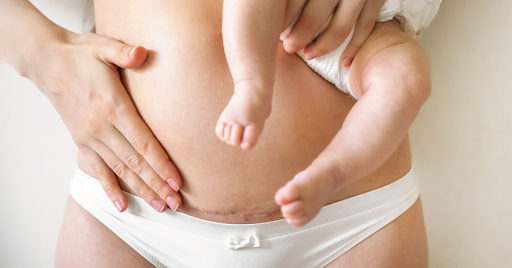The National Institute of Health describes a vaginal birth after a cesarean section (VBAC) as a vaginal delivery in a woman who has given birth via cesarean section in a former pregnancy. Having a vaginal birth is generally easier on a woman’s body, making recovery time shorter and less painful. Data indicates that between 60-80% of all trials of labor after cesarean and VBACs are successful.
Vaginal Birth After Cesarean
If you had a cesarean section with your first pregnancy, you may wonder if having a vaginal birth after a cesarean section (VBAC) could be an option with your next baby. A VBAC is possible for many women, but there are several factors to keep in mind. Here at Raleigh OB/GYN, we have put together a comprehensive list of what you need to know about vaginal birth after cesarean.
What Are The Benefits Of A VBAC?
Just with any procedure or birth plan, there are benefits and risks associated with vaginal birth after cesarean. Many women find that the benefits of VBAC outweigh the risks. Some of the main benefits include
- No abdominal surgery is required when VBAC is successful. This cuts down on the risks associated with C-sections.
- Recovery time after vaginal birth is usually shorter and requires less bed rest than a cesarean. You will still need to heal, but you won’t have an abdominal incision to worry about, and there will be fewer restrictions on walking around and lifting things.
- Individualized birth plans are possible with vaginal birth, rather than a C-section where surgery is planned. So, if you want to have the experience of labor and delivering your baby, VBAC can make that possible.
- Effect on future pregnancies: Having multiple C-sections will increase your chances of requiring scheduled cesarean for future pregnancies. If you plan on having a larger family and want to reduce your chances of needing another C-section, VBAC is a good option.
Less blood loss is also involved with vaginal birth (including VBAC) than with surgery (including a c-section). Always consult your provider when formulating your birth plan to see if they recommend certain interventions.
What Are The Risks Of A VBAC?
The risks associated with a VBAC are generally less than the risks of a C-section, but only if the VBAC is successful. If your doctor is monitoring your delivery and feels there is a danger to you or the baby, a C-section may be necessary, and then the risks associated with cesarean are of concern. More serious complications come into play when the VBAC is attempted but fails. Failed Trial of Labor After Cesarean (TOLAC) complications include uterine rupture, which necessitates an emergency C-section and a possible hysterectomy if the rupture is severe.
Who Makes A Good Candidate For A VBAC?
When deciding whether you are a good candidate for vaginal birth after cesarean, your doctor will speak to you about your medical history, along with past births. Some things that would make a good candidate for VBAC include
- You are only pregnant with one baby and have had 1 or 2 C-sections with low transverse incisions and have no problems that would prevent or complicate VBAC.
- You are pregnant with one baby and have had 1 C-section with an unknown type of incision that is not suspected to be a high vertical (classical) uterine incision and have no problems that would prevent or complicate VBAC
- You are pregnant with twins, have had 1 C-section with a low transverse uterine incision, and meet other requirements for a twin vaginal delivery
If you have had a prior C-section with a high vertical uterine incision, certain types of uterine surgeries, such as fibroid removal, or a prior uterine rupture, your doctor will most likely rule out VBAC.
Not all doctors and hospitals offer VBAC, but the physicians at Raleigh OB/GYN will work with you if that is part of your ideal birth plan. We will make sure you meet the requirements to be a good candidate for a vaginal birth after cesarean and monitor you during labor to make sure things are going well, and both you and baby are safe and healthy. If you have more questions, our team of physicians, nurses, and medical staff are here to help! For more information on vaginal birth after cesarean, give us a call at 919-876-8225 or request an appointment.


